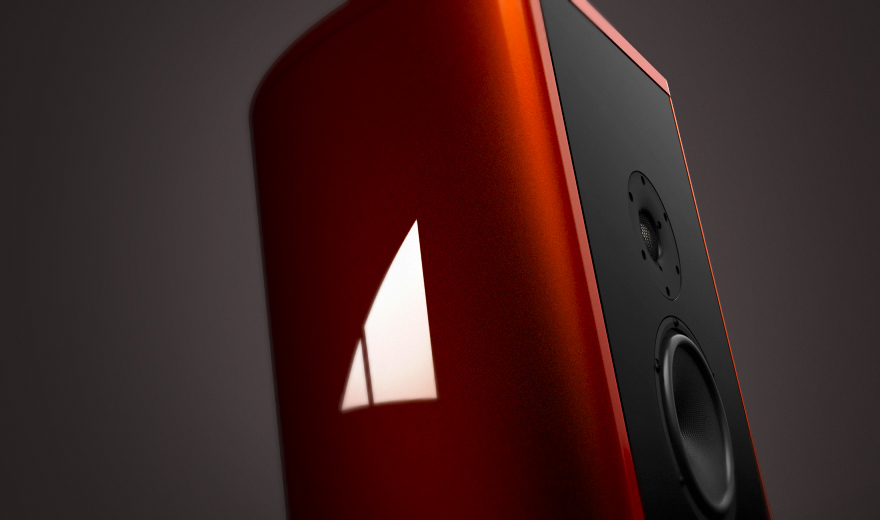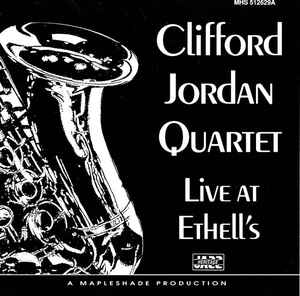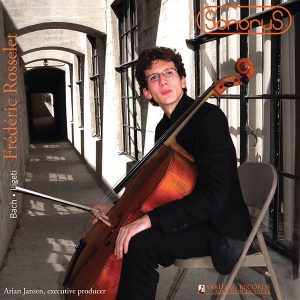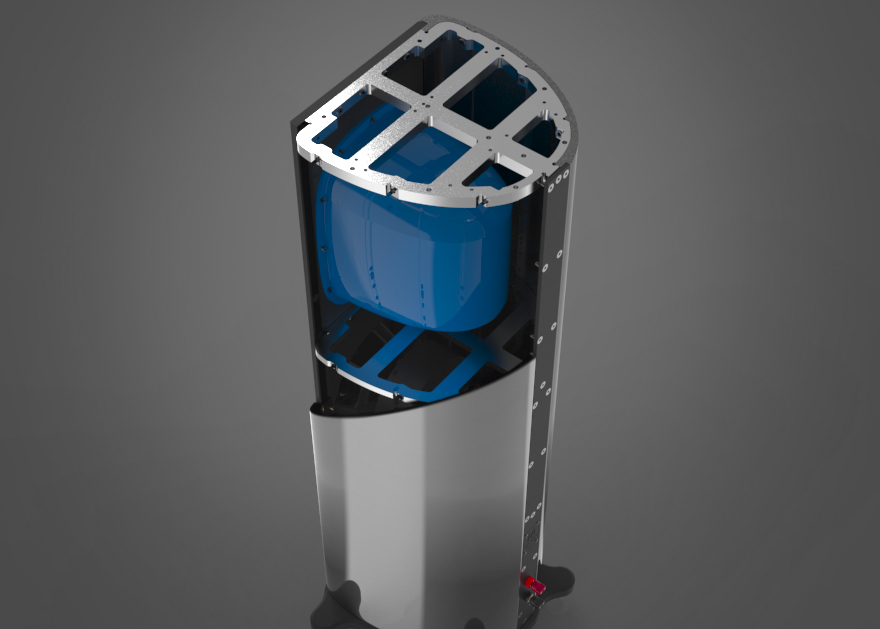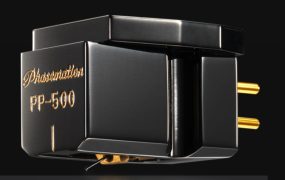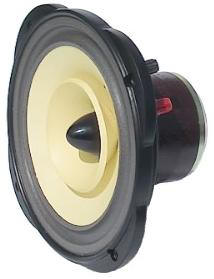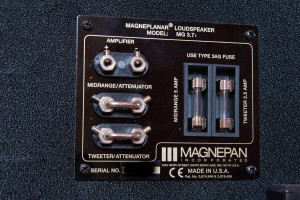Speakers—out of all the components in the audio chain— have seen the biggest advancements in performance over the last couple of years. Cabinet design. Driver design. Enclosure and driver materials. Computerized speaker design and crossover modelling. In house machining and construction. These factors and a few more have gone a long way to elevating high-end speaker performance a couple of notches as heard here with the new Magico S5 Mk. 2 Loudspeakers.
Magico, based out of Hayward, CA is one of the companies at the cutting edge of this revolution in high-end audio speaker design. The new Mk. 2 version of their highly regarded S5 speaker represents the embodiment of designer Alon Wolf's basic design philosophy, "how do you build without compromise? In other words, "solve an issue without creating new ones?" The only way to accomplish that goal designer Alon feels, "is to support with proper engineering. For instance, give up efficiency and all one needs is a bigger amplifier. That's in contrast," continued Alon, "to resorting to gaining efficiency with ported bass and having to deal with unmitigated problems like group delay, port noise, and restricted low extension." Like the Mk. 1 version, the new Magico S5 Mk. 2 is a three-way design with 2 x 10-inch woofers, 1 x 6-inch midrange and 1 x 1-inch tweeter all housed in an aluminum enclosure. That's, however, where any similarity—both physically and sonically—between the two speakers begins and ends.

Speakers are only as good as the upstream components and the new Magico S5 Mk. 2's are no exception to the rule (the room being a given as the weakest link in the audio chain!). One needs to consider the weakest link around each of the components in the audio chain as well. Everything and anything including the AC power supply, vibration isolation, and cables go a long way toward reaching the speaker's potential. Especially when it comes to truly realizing the Magico S5 Mk. 2's see-thru transparency. Not surprisingly, that old adage crap in, crap out still holds true with the biggest bang for the buck coming with improvements to the front-end source.
Take for instance the new Doshi Audio V3.0 tape stage. Designer Nick Doshi recently drove up from Virginia to New York City to install his latest attack on the state-of-the-art in tape playback electronics into the system. Nick felt after a little listening that the system was missing some of the sense of space his tape stage was capable of rendering. As it happened, the Transparent Audio Ref. XL Gen 5 interconnects used between the King-Cello tape stage and conrad-johnson's GAT series 2 preamplifier needed recalibration for the Doshi tape stage. A week later the recalibrated Transparent interconnects arrived back from Maine and instant improvement.
Magically appearing was that missing ambience along with the audience talking and silly little things like the sound of glasses clinking on Jonathan Horwich's (Int. Phonograph, Inc.) lovingly transferred second generation, 15 ips, 2-track direct copy of Pierre Sprey's (of Mapleshade Records) Clifford Jordan Live at Ethell's. No, the only the way it gets any better than this would be running the original master tape! The bass was so much cleaner and pulled out from the mix after recalibration. Astonishingly revealing but at the same time amazingly musical. Along with a huge helping of unrestrained dynamics. Now the original ‘90s Mapleshade CD had some good qualities but the disc also was sadly plagued by a hardness that always prevented me from becoming engaged in the music. Not with the tape!
Rock Solid Performance
With all their virtues, putting my finger on that one, single quality that sets the Magico S5 Mk. 2s apart from the competition proved frustrating. Then the proverbial light bulb went off after a visit one day by some audiobuddies! What differentiates the Magico S5 Mk. 2s from other speakers on the market is not what they do but what they don't do. It's way the speakers get out of the way of the music. It's the way the speakers totally disappear—despite their size—from the listening equation. No, it's not just that they are exceedingly transparent or uncolored though those two qualities are certainly a significant part of the picture. No. It's a function of the speaker not doing anything to attract attention to themselves. Their interaction with the room. A reduction in both cabinet and driver colorations. And much more. When all is said and done, what's left is a "stage" instead of a soundstage. A quality that very few speakers are capable of conveying. Now that "window" onto the stage isn't up to the dimensions—especially when we're talking about height—of a bigger, planar or line source speakers. But that stage is well proportioned and the size of instruments isn't exaggerated and the speakers do justice to both small and large scale music. Whatsmore, the best live or well recorded albums have when called for a stunning sense of hall presence or ethereal feeling.
One such album is the latest reissue of Dave Wilson's 1988 recording Winds of War and Peace (Analogue Productions APC-8823) with Lowell Graham and National Symphonic Winds. While I was never a huge fan of the original album—despite HP's accolades—this newly remastered version by Kevin Gray of Cohearent Sound really shows there's a lot more life in the old lady than ever thought. In fact, there's no question after listening to the LP that I'll be ordering when it's released the reel-to-reel tape from Acoustic Sounds' Ultra Tape series. The most spectacular sounding cut from Winds of War and Peace is the John Williams/Cunrow composition Liberty Fanfare written for the rededication and 100th anniversary of the Statue of Liberty. Renowned for its strings and brass and fanfare themes, Liberty Fanfare is far from an easy piece to record. And even harder to playback. The Magicos—beginning with their transparency to recreation of recreation of space to plumbing the depths to unrestrained, powerful dynamics to a massive stage to string tone—didn't disappoint. The new tweeter also demonstrates its mettle here with its airiness, smoothness and effortlessness. Far, far more refined than the Mk.1's tweeter.
Now some might call my room on the small side (the room is really medium size when all factors are considered). In the end, the listening perspective is a little more "intimate" replete with rock solid imaging and great staging (especially when it comes to stage width with instruments several feet out on either side of the speakers). The addition of the new VPI Vanquish direct-drive table and Atlas SL cartridge on the LP side and Doshi V3.0 tape stage on the reel-to-reel front didn't hurt matters either and showed that these speakers are capable of even more than I thought possible. In fact, inserting a pair of Nick's earlier supplied Phillips 12DW7s tubes for the seemingly ever problematic JJ vacuum tubes in the phono stage added even more soundstage depth and airiness to the recordings.
But interestingly, it's the solidity and focus of the speaker's center image that is most improved in the latest version of the Magico S5. No, it' not a result of speaker positioning as the Magico S5 Mk. 2s are for all intents and purposes sitting in the same spot as the earlier Mk. 1 version. No, this improved center image solidity, "wasn't traceable to better matching of parts between speakers," Alon said, "since their parts between speakers are already tightly matched." The correct answer according to Alon was, "a result of the of the Mk. 2's new, rounded top plate. Not only does the rounded shape reduce diffractions (standing waves within the enclosure)," says Alon, "but it reduces the standing waves between the top of the speaker and the ceiling. All of which" he added, "are measurable." And the S5 Mk. 2 is the first Magico speaker to incorporate this advancement in enclosure design (sure it will make its way into other speakers in the Magico line too!).
None of the speaker's vanishing act would be possible without those quintessential Magico speaker qualities: quietness, settling time and transparency. An eerie quietness. A transparency that extends from top to bottom of the musical spectrum. As many have found out the hard way, transparency is possibly the hardest playback quality to achieve and the most easily lost. As we all know, audiophiles just can't stand to leave well enough alone. One more little tweak and I'll achieve nirvana. Then bang. You've lost that transparency and no matter what you do the magic is gone! There's no better test of the Magico S5 Mk. 2's transparency than second generation reel-to-reel tape, one of those simply miked and recorded early 2-track jazz recordings or a direct-to-disc LP. One long time reference LP for transparency remains Acoustic Sounds' 45 rpm rerelease of Poll Winners 3 (Acoustic Sounds/Contemporary 7010) featuring the trio of Shelly Manne, Barney Kesssel and Ray Brown. There's a striking clarity to the sound of this simply miked and early stereo '57 Contemporary recording; Manne's drums in the back of the mailroom are seen in the "minds eye!" Kessell's guitar seems like it's in the room with you!
The biggest improvement in the new S5 Mk. 2 relative to its older sibling, however, lies in the midrange and the introduction of the new lighter and stiffer nanographene drivers. Nor did Alon stop with the new midrange driver either. The new nanographene drivers allowed Alon to remove the breakup mode traps and simplify the speaker's crossover. And to round things out, Alon placed the new nanographene driver in that specially designed internal midrange enclosure originally developed for the S3 Mk. 1 speakers. The combination of parts in the crossover and new driver technology elevated the speaker's midrange—when everything else is right—to rivalling that of stats. Quick, agile, clean and capable of resolving the subtlest nuances are just a few of the terms describing the performance of the new nanographene driver and the S5 Mk.2's midrange. While the Mk. 1 was certainly no slouch in this area, the new Mk. 2 version is simply on another level when it comes to the reproduction of the ever-so-critical midrange area. There was in the S5 Mk. 1 version an ever so slight loss of linearity, transparency and low level resolution when transitioning from the bass to the midrange area. It could be heard as a slight unfocussed quality, a slight smoothing out of the midrange or a loss of the resolution heard above and below the midrange. Take something from the simply recorded 45 rpm reissue of a cut like "Everybody Loves Somebody" from Dream with Dean (Analogue Productions APP 076-45). Not only there a greater visceral sense but—and it's really hard to put into words—an eerie feeling of Martin at times moving toward the listener. There's a whole ‘nuther layer of resolution to Martin's vocals. The finest inner details, textures and nuances of his voice come to the fore. The celeste at the opening of "Everybody Loves Somebody" also demonstrates the same increase in resolution as well as a greater sense of harmonic decay and lightness.
Another example is the original (the reissue pales next to the original) and perhaps one of the best direct-to-discs ever released Moonlight Serenade (Jeton 1003315). The first track on the album "Round About Midnight" (Beethoven/Thelonius Monk) featuring the duo of Ray Brown and Laurindo Almeida is about as lifelike, relaxed and natural sounding as a recording gets. Jazz meets classical. Bowed bass meets acoustic guitar. When everything is spot on, the speakers retrieve the smallest nuances engraved into the record grooves. Everything from the subtlest playing, the feeling of strings being depressed, held and released, the feeling of tension and release, the harmonics surrounding the guitar and most of all its incredible delicacy of Almeida's acoustic guitar. Even more impressive is the speaker's resolution at low volume levels. Like the best electrostatics, there's no need to play the system at nerve jangling volume. Oh and without tipping my hand, Ray Brown and his bowed bass will shake, rattle and roll your bones.
Admittedly Magico's S5 Mk. 1 was no absolutely slouch when it came to reproducing the lowest octaves but here too designer Alon Wolf stepped up the speaker's performance. Take for example, Yarlung Records' 15 ips, 2-track reel-to-reel tape recording of Frederic Rosselet performing Bach's Suite No 3 for solo cello in C Major, BMV 1009 (Yarlung Records).
The speakers have an ability to convey the instrument's warmth and tone—without exaggeration—or embellishment. (A large part of that ability to convey the warmth of the cello is also directly traceable to the performance of the conrad-johnson ART amplifiers and new Atlas SL too in this region.) That ability to capture the friction and stiction of Rosselet's bow gliding across the strings. Interestingly, I wonder whether the improved bass is due to the speaker being easier to drive, a better speaker in this region or some combination of the two? Gone also in the Mk. 2 is the slight instrumental wander heard with other speakers. Fast forward to the second piece on this tape with Rosselet performing Gyorgy Ligeti's Sonata for solo cello. Marked forte vigoroso and showing the tritone influence of Bartok, there's a portion in the opening theme of the piece that culminates in crescendo that serves nicely to illustrate just how well the speaker maintains its grip on the music, no matter its complexity. At the same time the Rosselet also nicely demonstrates the speaker's ability to render—as tape is want to do—the S5 Mk. 2's unrestrained low frequency dynamic range. No compression, no monoing of the signal. No just the music the way it was intended to be heard.
When it come to the 12-inch black discs, either the Marius Constant's 14 Stations pour percussion et Six Instruments (Erato STU 70603) or Carlos Chavez's Toccata for Percussion Instruments from my long time reference disc Super Percussion (Super Analogue SSY 19) also illustrate quite nicely the Magico S5 Mk. 2's low frequency extension, impact and sheer speed. There's no question that the clarity in the bass region, crossover design contributes to the speaker's linearity and exceptional midrange performance. The extension of the drums and energy and air moved by the drums on the Constant composition or transparency, three-dimensional holography and differences in the sizes of the drums used on the Chavez piece makes one sit up and take notice right away.
Is There A Speaker That Makes Everyone Happy?
Quite possibly.
There remains the ages old debate—even with all the advances in speaker design—whether one speaker can satisfy two masters? Can one speaker be both revealing and neutral enough for designers, studio engineers and reviewers yet stay faithful to the program material for music lovers? Certain earlier Magico designs fit the bill when it came to resolution yet some were left wanting when it came to realizing the ultimate goal of being musical and involving. Then came Magico's S-series. The "S" as I commented on in an earlier review (HERE) stood for soul. There was just more meat on the bones. The newest S5 Mk. 2 follows in the footsteps of its predecessor while at the same time incorporating much of the technology what designer Wolf developed for his outstanding limited edition M-Project concept speaker and refining the sound. The latest S5 Mk. 2 won't add artificial saccharin sweetening to the music or pleasantness. What the speakers will do offer is a great balance that allows you to appreciate the beauty of music and recording. To fulfill that quest for a concert in your home. To when the music calls for it, to kick some butt and ask questions later.
The new Magico S5 Mk. 2 retains the tradition Magico familial traits of quietness, transparency, neutrality and linearity from top to bottom of the frequency spectrum. At the same time, pretty much all other areas are improved most notably being dynamics and a reduction in midrange colorations. Where the S5 Mk. 2 strays the most from say Magico's more expensive M3 speaker lies in the areas of having that "relaxed" quality, ultimate low level resolution and finesse. Yet, the Magico S5 Mk. 2 might just be the sweet spot in the Magico speaker line, providing a big gulp of the more expensive M3 without the associated price tag.
The Magico S5 Mk. 2 is one speaker that every audiophile owes a listen to under properly setup conditions! This speaker could be the end of the search for the Holy Grail in speakers for some audiophiles.
Technical Highlights
Magico S5 Mk. 2 and S7 speakers share common technology and a more in depth discussion of the technical details can be found HERE.
For others, here's The Readers Digest version of what's new and improved in the Magico S5 Mk. 2 beginning with the drivers. The latest Mk. 2 version includes a new 1-inch diamond coated Be tweeter (MG7) with long throw voice coil. This new driver has lower distortion and integrates better with the midrange than its older sibling. Next, a new 6-inch multi-wall carbon and nanographene (MAG6004RTC) driver is used for the midrange. This new driver is 30% lighter and 300% stiffer than the transducer used in the Mk. 1 version. In addition, a mid-sub enclosure made of proprietary polymeric material acoustically optimize the midrange driver's operating environment. Finally, the lower frequencies are handled by a totally new 10-inch Al bass driver. Among the changes are a new motor system with twice the excursion of the previous model (15 vs 7 mm), more powerful magnets and nanographene dust caps.
The new Magico S5 Mk. 2 uses Magico's tried and true elliptical symmetry crossover stuffed with high quality Mundorf parts. This crossover design was selected so as to: 1) Maximize bandwidth; 2) Preserve phase linearity; and 3) Decrease IM distortion.
Lastly, the speaker enclosure is fashioned from extruded ½-inch aluminum, 16 inches in diameter. This 3D convex shape serves to reduce internal standing waves as well as the speaker's interaction with the room. The S5 Mk. 2s are available in two distinctive finishes (M-Cast textured powder and M-Coat smooth high gloss) and many colors to match the listening environment.
Setup Notes
The Magicos were very easy to set-up compared to other speakers that I've reviewed over the years. Obtaining good sound from the S5 Mk. 2 wasn't difficult; like all speakers, getting great sound takes time and effort. One thing that amazed most visitors about the new Mk. 2s (the Mk. 1 shares this trait in common) was their exceptionally good sound even off axis.
The new S5 Mk. 2s arrived securely packed in large wooden crates. Each speaker—and that's rather fortunate since they tip the scales at 220 pounds each—comes factory mounted on rollers. The rollers go a long way to moving the speaker around and finding that optimal spot in the room for sound. After finding that sweet spot, the rollers are removed and manufacturer supplied spikes are threaded into the base of the speaker "outrigger." Removing the rollers is really a two person job but thanks to a bit of weightlifting background, I managed the task solo. Once spiked and levelled, the Mk. 2's with their new four point, lower and thicker base plate system is far more stable than the older Mk. 1's three-point system. Is there a downside to the new four spike configuration? Only one that I could find. Fine positioning of the speakers is a touch harder. After the dust settled, the speakers pretty much ended up where the Mk. 1s resided for a couple of years. In the end, the Magicos sounded best pulled out from the front wall into the room (pretty much like all speakers I've played with over the years) for better soundstaging and bass. Here, the speakers are roughly six feet from the front wall, two feet or so from the side walls and toed-in about 2 inches; the focal point being slightly in back of the listening position. That wasn't planned; it just shook out in the end. Toe-in is important, but not as crucial as the previous version because of the improved tweeter.
The S5 Mk. 2 comes, as did its predecessor, with aluminum grille covers. The covers are basically cosmetic and protective and should be removed for any serious listening sessions. A small supply of the round felt pads that go between the magnets and the front of the speaker is useful since the cushions tend to fall off with time and you don't to accidentally mar the speaker.
The Magico S5 Mk. 2s sounded excellent right out of the crate with the major part of the break-in process taking roughly 400 or so hours of playing. During this time, the bass and dynamics settle in, resolution improves markedly as does dynamics and the frequency extremes slowly extend. Then there's some smaller changes after another 200 or so hours of playing.
Magico S5 Mk. 2 Loudspeakers
Retail: $38,000 (M-Cast); $42,000 (M-coat)
Specifications
- Frequency response: 20Hz to 50kHz
- Sensitivity: 88dB
- Impedance: 4 ohms
- Minimum power: 50 watts
- Weight: 220 lbs
- Size: 48-inches high x 14-inches deep x 15-inches wide
Magico




